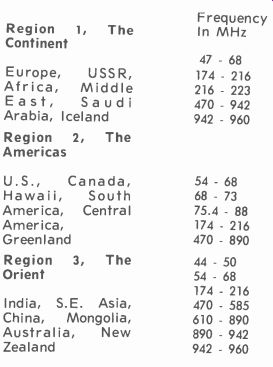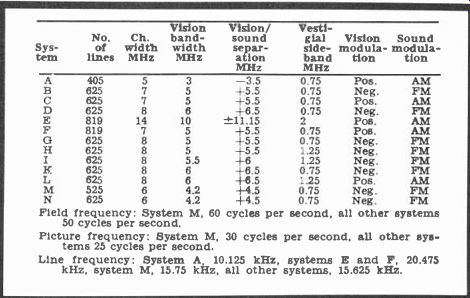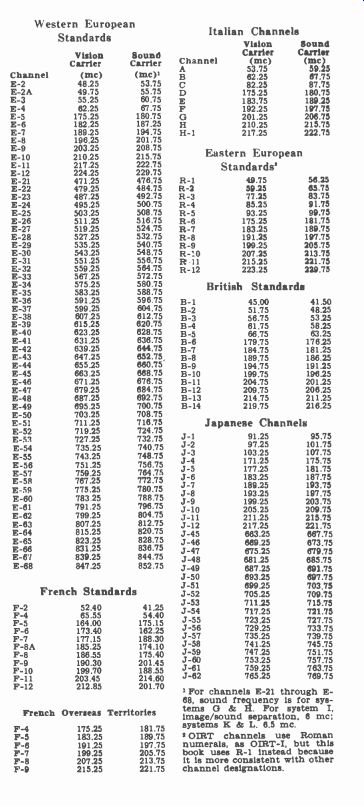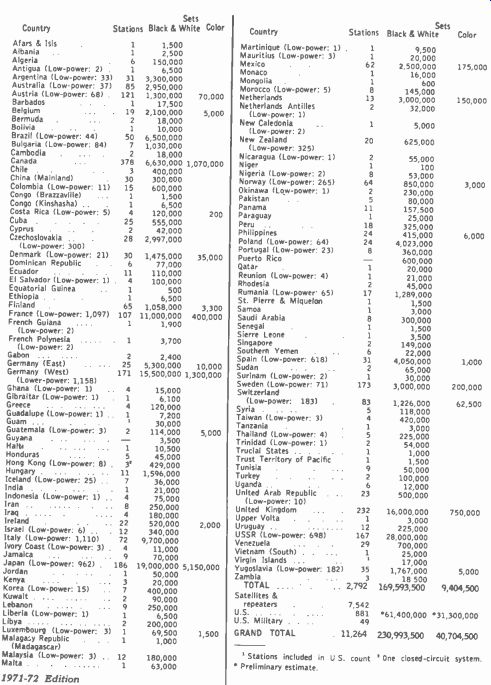At last count, there are about eight television systems used in the world, and some have certain features in common:
In those countries where electric current alternates at 50 Hz, the field frequencies are 50 Hz and the frame rate is 25 per second. Where the current rate is 60 Hz, fields are 60 Hz and the frame repetition is 30. The maximum video bandpass has been standardized at 3 MHz for the British 405-line system, 4 MHz for the U.S. 525-line system, 5.5 to 6.5 MHz for the 625-line European and French systems, and 10.4 MHz for the sideband 819-line Belgian and French systems.
Frequency allocations for these various systems in the three principal regions of the world are given by geographical location in Table 16-1.

Table 16-1. TV frequency allocations in the world regions.
----------

Region 1, The Continent
Europe, USSR, Africa, Middle East, Saudi Arabia, Iceland Region 2, The Americas
U.S., Canada, Hawaii, South America, Central America, Greenland Region 3, The Orient India, S.E. Asia, China, Mongolia, Australia, New Zealand
Frequency In MHz
47-68 174-216 216-223 470-942 942-960 54-68 68-73 75.4-88 174-216 470-890 44-50 54-68 174-216 470-585 610-890 890-942 942-960
-------------
There are also two important and very recent international Geneva agreements that should also be included:
1) In the 470 to 890-MHz UHF band, the frequencies of 620 to 790 MHz have been assigned to television stations in the FM band to receive satellite transmissions. However, these frequencies will not now be used in the U.S. by local agreement; only by foreign countries.
2) The UHF frequencies of 2500 through 2690-MHz have been assigned as Broadcast Satellite bands, along with 11.7 to 12.2 GHz.
The standard aspect ratio throughout the world (the ratio of picture width to height) is 4:3, and all systems have 2:1 interlace scanning to avoid the unpleasant effect of picture flicker. FM is universally used for sound modulation, except in older English transmissions and in France and Belgium where AM is the method used. Both U.S. and European systems have standardized on negative picture modulation, where the transmitter power decreases as televised scenes brighten.
England, France and parts of Belgium use positive modulation where power and brightness increase together.
Despite the continuing differences in the several European systems, there are now 22 countries in Western Europe and North Africa that are linked by the Eurovision Network, and there are additional links to the Intervision Network of Eastern Europe. Since the launching of Telstar 1 in July 1962, and the later Intelsat series of satellites, distant television transmissions have increased to the point now where, in the Intelsat 4 satellite series, there are channels devoted completely to television. Europe and the United Kingdom have also standardized in the past 20 years, so that in countries using 50-Hz fields, the BBC and ORTF now exchange international programs on the 625-line standard. In Europe, however, there are still the German and French systems where considerable conversion is always necessary, although it is easier to work between these two than among the previous 405, 625, and 819-line systems, respectively, of all three. The remaining outstanding problem between the German and French systems is that of chroma subcarrier frequency tolerance. The German PAL system specifications are normally tighter than those in the French SE CAM system, so conversions from German to French are relatively easy, but sometimes rather difficult from French to German.
The PAL and SECAM systems are evolutions of the U.S. National Television System Committee (NTSC) standards adopted in America in 1953. By 1960, the EBU-UER European television group finally decided upon the 625 line 50-Hz system, with a color subcarrier frequency of 4.43 MHz, based on 284.5 times the line frequency of 15,625 Hz. French, German, and U.S. systems transmit luminance and chroma separately, with the usual pair of color-difference signals that are modulated on color subcarriers. The color sync signal is also broadcast on the back porch of the horizontal sync pulse. The following description of the PAL and SECAM systems includes an evaluation supplied by NBC's Jaro Lichtenberg, a native of Czechoslovakia.
The German PAL System The Phase Alternation Line television method was developed by Walter Bruch in 1961. Here, the phase of the chroma is alternated 180 degrees from one line to the next so it appears out of phase on every other line and therefore cancels differential phase errors. This requires that a line-switching signal must be transmitted also, as well as a synchronizing color burst. The result, though, is that there are few, if any, transmission phase errors, and a hue control as we know it in the United States is unnecessary. Compared to NTSC, the burst does not have the same type phase, but alternates first positive then negative 45 degrees (from 0 or burst) as it is transmitted from line to line, with changes being made by the line switching signal. At the receiver, this alternating burst is decoded and used to sync the burst so that the local subcarrier oscillator is firmly synchronized with the transmitter.
In color transmission, PAL transmits only R-Y and B-Y (since G-Y is a combination of R-Y, B-Y and luminance) NOT I and Q as in the NTSC system. Both R-Y and B-Y double sidebands with bandwidths of 1.7 MHz below and 1.3 MHz above the subcarrier are transmitted to relieve as much chroma crosstalk as possible.
While NTSC completes its vertical scan in two fields and at 30 frames per second, PAL operates with 25 frames per second and four fields. The frequency of the color subcarrier then turns out to be:
Fsc = (284-!"T) FL + 25 Hz = 4.43361875 MHz
The 25 Hz is an offset added for frequency compatibility with monochrome receivers. FL, of course, represents the line frequency, and 14 is the difference between the field rate of the color system and the 50-Hz power line alternation.
There are at least three PAL demodulation schemes, from bare necessities to a deluxe version that even eliminates most recording errors. Simple PAL demodulation is about the same as R-Y and B-Y NTSC (perhaps two tubes, a pair of diodes, or two transistors) and chroma errors appear as changes in saturation. Standard PAL demodulators have a built-in delay line that offers many advantages including substantial elimination of both phase and saturation distortion. The third type, which probably appears only in high-priced television monitors, virtually eliminates all types of chroma and phase errors, especially time-base distortion. Here, each horizontal scanning line is regenerated with very close 4.43-MHz chroma sync over the entire line and all errors are carefully removed.
THE FRENCH SECAM SYSTEM
The SECAM abbreviation stands for Sequential With Memory, and was invented by Henri de France in 1957. It differs considerably from the NTSC system. Like PAL, however, it transmits R-Y and B-Y signals in sequence, but with a time lag of one line (64 microseconds) between them.
Therefore, the French may use simple frequency modulation, instead of quadrature AM Modulation, to broadcast color information. R-Y is transmitted for one line then B-Y for the next, with color sync switching at the beginning of each field.
In reception, the R-Y line has a positive sawtooth ramp that synchronizes the demodulator switching for satisfactory transmitter-receiver lock, and B-Y probably has the inverse.
Therefore, a delay line is necessary in the receiver to retain the information of the first line while the set is reading the second line so the demodulator can operate on two lines together, decoding R-Y and B-Y simultaneously.
We are informed that there have been at least four versions of SECAM before it went on the air, with IVB being a version modified by the Russians, and introduced in Finland during 1968. Reportedly, it is closer to NTSC than previous SECAM versions.
SECAM I was the initial and simplest system with straight AM modulated R-Y and B-Y transmitted without sophisticated RF processing such as filtering, shaping, etc.
SECAM III synchronized an encoder and used FM modulation so that receiver decoders (demodulators) would lock at more precise frequencies and supply more accurate chroma information.
SECAM III was further modified to avoid image streaking and visible moire, plus certain incompatibility with monochrome transmissions.
SECAM IV, the 6.5 MHz system now in use throughout France and Russia, has been further developed with certain system time constants attenuated, along with modifications to the 4.43-MHz subcarrier, but it still transmits 1.5-MHz chroma sidebands. There is, however, R(red) pre-emphasis to in crease energy in the lower and upper sidebands, which is then de-emphasized in the receiver to reduce color noise. It is expected that at a later date, the Russians will change over to SECAM IVB because of its added advantages over SECAM IV.
It is also understood that in the IVB conversion, the Russians have further suppressed the subcarrier to remove its visibility on black-and-white reception and reinstituted the NTSC burst.
In regular European transmissions, our informant adds that the French are actually using the PAL system (at least in some instances) up to the transmitter, then coding PAL into SECAM for all French broadcasts, undoubtedly because of the large distribution of French receivers through the country.
-------------------

Table 16-2. TV system characteristics. (Courtesy TV Digest) Field frequency: System M, 60 cycles per second, 50 cycles per second.
Picture frequency: System M, 30 cycles per seco tems 25 cycles per second.
Line frequency: System A, 10.125 kHz, systems kHz, system M, 15.75 kHz, all other systems, all other systems nd, all other eye-
E and F, 20.475 15.625 kHz.
------------------


Table 16-3. World TV channel frequencies. (Courtesy TV Digest)
Table 16-4. World TV stations and receivers. (Courtesy TV Digest)
OTHER WORLD STATISTICS
There are three other tables of interest that were made available to us by Television Digest's TV Factbook, 2025 Eye St., N.W., Washington, D.C. 20006. Table 16-3 is a listing of World television frequencies by channel numbers and video-audio carriers. And from the same publication, we've included the numbers of lines, channel bandwidths, and other vital statistics in Table 16-2, and the numbers and locations of the world's B&W and color television receivers in Table 16-4.
Also see:
TV Antennas and Transmission lines
Air Time--An Intro to Television Broadcasting
TV and Radio Tube Troubles (1958)